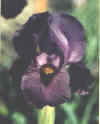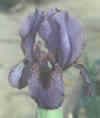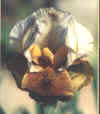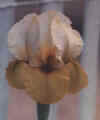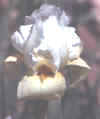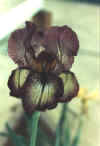 WANDERLUST (Seligmann, 1985) OGB Orchid standards, dusty rose falls with a heart-shaped area that is flecked deep burgundy and ivory. Heart Stealer X Martha Mia. Fully fertile halfbred that transmits good form and substance, as well as interesting stippled-type signal. I recommend it highly to
beginners. This was a name in search of an iris, which this particular clone got simply because the other candidates that year were quickly matched with appropriate names. At that time, Gus and I were working together. I cultured all of our seedlings. The small seedlings spent their first winter under lights in Gus' house. We then lined them out in Gus' yard for the first year. They might move back and forth between our two gardens several more times before they were ready for introduction. The in-joke was that the strong ones got that way by toting their suitcases back and forth for all those moves between the mesa and town. WANDERLUST (Seligmann, 1985) OGB Orchid standards, dusty rose falls with a heart-shaped area that is flecked deep burgundy and ivory. Heart Stealer X Martha Mia. Fully fertile halfbred that transmits good form and substance, as well as interesting stippled-type signal. I recommend it highly to
beginners. This was a name in search of an iris, which this particular clone got simply because the other candidates that year were quickly matched with appropriate names. At that time, Gus and I were working together. I cultured all of our seedlings. The small seedlings spent their first winter under lights in Gus' house. We then lined them out in Gus' yard for the first year. They might move back and forth between our two gardens several more times before they were ready for introduction. The in-joke was that the strong ones got that way by toting their suitcases back and forth for all those moves between the mesa and town. |
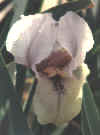 WANNABEE (McAllister, 1996) OGB- What do you wannabee ("want to be") when you grow up? This one wanted to be pastel – and almost made it with its pale blue standards and pale buff-green falls. It also wanted to have a large signal – and its stippling almost coaleses to form a solid signal. It wanted to be veined, too – and has fine veins flanking the beard, but they don't extend down the blade of the fall. In other words, it looks like it couldn't make up its mind what it wanted to be – but it's so different that it certainly succeeds in getting the attention of garden visitors. Mohric Art X Heavenly Sunlight. WANNABEE (McAllister, 1996) OGB- What do you wannabee ("want to be") when you grow up? This one wanted to be pastel – and almost made it with its pale blue standards and pale buff-green falls. It also wanted to have a large signal – and its stippling almost coaleses to form a solid signal. It wanted to be veined, too – and has fine veins flanking the beard, but they don't extend down the blade of the fall. In other words, it looks like it couldn't make up its mind what it wanted to be – but it's so different that it certainly succeeds in getting the attention of garden visitors. Mohric Art X Heavenly Sunlight. |
 WAR DRUMS (McAllister, 1996) OGB Think of a moonless night on the prairie, smoky campfires, and the foreboding sound of war drums beating in the distance. Standards are a
smoky-grey with a faint touch of violet and a few faint yellow veins. Style arms are an intense flame-yellow, brushed with reddish-violet along the midribs and the stylecrests have reddish-violet "eyelashes". In contrast, the falls are deep reddish-black with a dense near-black beard. A fully fertile ½-bred from Deborah's Song X Turkish Tangent, which I'm using for sun-fast reds and reddish-blacks. WAR DRUMS (McAllister, 1996) OGB Think of a moonless night on the prairie, smoky campfires, and the foreboding sound of war drums beating in the distance. Standards are a
smoky-grey with a faint touch of violet and a few faint yellow veins. Style arms are an intense flame-yellow, brushed with reddish-violet along the midribs and the stylecrests have reddish-violet "eyelashes". In contrast, the falls are deep reddish-black with a dense near-black beard. A fully fertile ½-bred from Deborah's Song X Turkish Tangent, which I'm using for sun-fast reds and reddish-blacks. |
|
|
| WAYFARING STRANGER (Hunt-McAllister, 1988) OGB Pedigree lost, but it breeds like a fully fertile half-bred (I've given away most of its seeds). Lavender standards, smoky-tan falls with violet flush and smoky red dotting and veining and deep maroon signal spot. So far, none of its offspring have been outstanding. The name comes from the old gospel song. According to Gene's records, this seedling came from an accidental dual cross – so it was in many senses a stranger among the other seedlings – and I was unable to determine which was more likely so registered it as parentage unknown. |
|
WELCOME REWARD (Sundt-Rich, 1971) OB Lilac standards veined deeper; gold bronze falls, veined mahogany. Dark brown signal, golden brown beard. Austin W 142 (onco interspecies cross) X Pink Formal. Long-time favorite of those working toward true pinks because it carries a double dose of the t-factor. It hasn't given me any pinks, but it has produced a lot of nice things along the way. Also recommended for beginners who want to experiment with oncobreds. |
|
|
 WHIRLING THUNDER (McAllister, 1992) OGB Violet standards, purple falls and deep ruby-red signal spot are all overlaid with dark
grey. Gethsemane X Ora J. Seale. A fully fertile ½-bred whose offspring are quite diverse in color and pattern. Some have very striking signals. Reminiscent of storm clouds, yes, even whirling ones like tornados, but it was actually named for a Sauk warrior. Whirling Thunder was the son the the war chief, Black Hawk. A case of wanting an iris that matched the name – but this is not an offspring of the iris I named in honor of Black Hawk. WHIRLING THUNDER (McAllister, 1992) OGB Violet standards, purple falls and deep ruby-red signal spot are all overlaid with dark
grey. Gethsemane X Ora J. Seale. A fully fertile ½-bred whose offspring are quite diverse in color and pattern. Some have very striking signals. Reminiscent of storm clouds, yes, even whirling ones like tornados, but it was actually named for a Sauk warrior. Whirling Thunder was the son the the war chief, Black Hawk. A case of wanting an iris that matched the name – but this is not an offspring of the iris I named in honor of Black Hawk. |
|
|
|
|
|
WHISKEY MACK (Danielson, 1982). RB S heavily veined gold, violet veining on midrib with rust brown coloring next to style arms, gold edge; Stars Over Chicago X Genetic Artist. |
 WHITE ARTS (Danielson, 1986). RB+ (Snow Flurry x I. hoogiana)
X I. hoogiana. Registered as simply a white self with a
white beard, but I've noticed a touch of yellow in the throat. Relatively
few arilbreds carry genes from only a single aril species, but this one clearly
shows its hoogiana heritage. See Hoogianabreds
for more information about this type. WHITE ARTS (Danielson, 1986). RB+ (Snow Flurry x I. hoogiana)
X I. hoogiana. Registered as simply a white self with a
white beard, but I've noticed a touch of yellow in the throat. Relatively
few arilbreds carry genes from only a single aril species, but this one clearly
shows its hoogiana heritage. See Hoogianabreds
for more information about this type. |
|
|
|
|
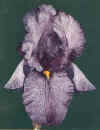 WILLIAM MOHR AB (Mohr-Mitchell, 1925). Introduced
even before the color codes were developed this was classified as an S7M, which
was translated as a "Pink to red-toned blend, self, medium" for the
1976 Checklist. Although this was corrected in a subsequent errata, the
description has unfortunately been repeated many times down through the
years. The Court of Iris said: "Huge lilac flowers have veins of deeper
violet" and the photo confirms this. Parisiana X I. gatesii. WILLIAM MOHR AB (Mohr-Mitchell, 1925). Introduced
even before the color codes were developed this was classified as an S7M, which
was translated as a "Pink to red-toned blend, self, medium" for the
1976 Checklist. Although this was corrected in a subsequent errata, the
description has unfortunately been repeated many times down through the
years. The Court of Iris said: "Huge lilac flowers have veins of deeper
violet" and the photo confirms this. Parisiana X I. gatesii. |
|
|
|
WINE AND LILAC (Wilson, 1995). S. clear lilac, lightly veined blue at rib; F. lilac lightly flushed rose, large burgundy rose signal; wide purple violet beards; no fragrance. 28-90BBO-D: (Bionic Burst x Onlooker) X 35-890TW-D: (Onlooker x Tornado Warning). |
|
WISHED FOR CHILD (Hunt, 1987) OGB Pale lilac standards; grey-yellow ground of falls is overlaid rose-buff and delicately veined brownish purple. (Blue Gate x Jallah Effendi) X Tuesday Song. A fully fertile halfbred that passes its smooth, rounded form on to its children. With Whirlwind Tour, it has produced fully fertile seedlings with rounded form and onco-like veining, some of which are under consideration for introduction. It apparently carries some genes for shorter stature because it has also proven useful in working toward strong-growing, but downsized halfbreds. I obtained a number of seedlings from it by pollen from an onco hybrid of the Susiana group, using forced germination. Fortunately, a few of the best have proven to be exceptionally fertile for the type and I'm using them in my attempts to inject heavily textured dotting and veining into arilbred lines. I tried to continue Gene's practice of using Biblical names, but that often proved something of a challenge. One I considered was "Miriam", but it had already been used – when I learned that one translation of Miriam is "Wished-for Child", I felt it was most appropriate. |
|
WITCH DOCTOR (Plough, 1955). OB Lavender-grey blend. TB seedling X Capitola. |
 WORK OF DORCAS (Hunt, 1988) OGB Grey-violet standards, light rosy-violet falls, some veining. Dorcas x Boaz. From Gene's lines using short oncos to down-size
arilbreds, it's actually a fully fertile ½-bred that is median in size, rather than by ancestry. Because of its stature, I've used it in my work toward fertile arilbredmedians – but I have nothing to report concerning its use with conventional halfbreds because I've given away all seeds produced that way. I don't know Gene's exact logic, but it doesn't take a giant leap of imagination to come up with this name for a seedling of Dorcas. WORK OF DORCAS (Hunt, 1988) OGB Grey-violet standards, light rosy-violet falls, some veining. Dorcas x Boaz. From Gene's lines using short oncos to down-size
arilbreds, it's actually a fully fertile ½-bred that is median in size, rather than by ancestry. Because of its stature, I've used it in my work toward fertile arilbredmedians – but I have nothing to report concerning its use with conventional halfbreds because I've given away all seeds produced that way. I don't know Gene's exact logic, but it doesn't take a giant leap of imagination to come up with this name for a seedling of Dorcas. |
|
|
